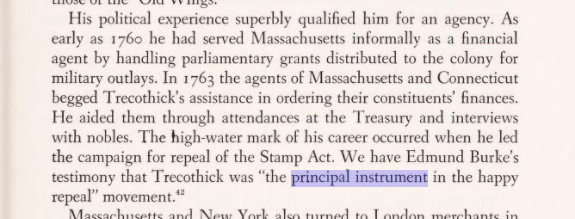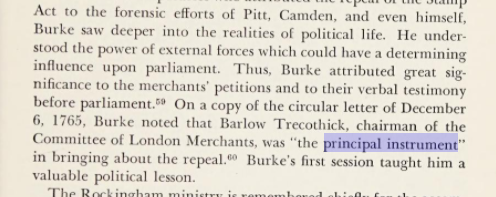Last week, as often happens, I found myself disappearing down a scholarly rabbit hole as I tried to resolve a familiar problem: the issue that arises when two or more secondary sources conflict about a matter of historical fact. Divergence in the historical literature is, of course, entirely normal, but it does force any writer to make a decision about which “side” they think is the most reliable. In this instance, the divergence came down to a simple issue of whether or not a comma was present in the manuscript annotation of a 1765 letter. The annotation could be read in two different ways depending upon whether the comma was there or not. This was a puzzle that, as a perfectionist and a pedant, I couldn’t resist, even though it was not central to any of the arguments I was trying to make.
The annotation, which is typically attributed to Edmund Burke, appears on a copy of a circular letter that had been composed in concert between the Marquess of Rockingham, then Prime Minister, and merchant/political lobbyist Barlow Trecothick, in an effort to solicit petitions against the 1764 Stamp Act, which the pair were then seeking to repeal. The circular was very successful and prompted a deluge of petitions that significantly helped efforts to repeal the Act. Given the significance of the Stamp Act, and resistance to it, for historians of the American Revolution, this letter has been written about a great deal in the secondary literature, and the annotation which appears on it has been cited many, many times.

The annotation, above, reads:
N. B. This Letter concerted between the Marquess of R. & Mr. Trecothick The principal instrument in the happy repeal of the Stamp Act, wh. witht. giving up the British authority quieted the Empire
Although there is clearly not a comma after “Trecothick”, several sources—such as Kammen, writing in A Rope of Sand (1968), below—have assumed there was. In that case, the “principal instrument” becomes Trecothick, rather than the letter itself.

This is not, however, Kammen’s error. If we look at his footnotes, we see that he was, in fact, quoting from Carl B. Cone’s 1957 book Burke and the Nature of Politics: The Age of the American Revolution, see below.
As it turns out, the error was not in fact Cone’s; he was merely quoting from yet another source: the Earl of Albermarle’s Memoirs of the Marquis of Rockingham and His Contemporaries, below. Here, Albemarle, despite referring to the original manuscript, had inserted a comma after “Trecothick”, changing the meaning of the quotation as a result.

In a way, none of this really matters, but it does highlight a problem that is almost impossible to avoid in writing history: since we never have the opportunity to trace everything back to primary sources, we must rely on the work of others. Sometimes that work will be mistaken, even in a tiny way as it is here, and we will inevitably, although unintentionally, replicate that error. Although doing so goes against every fibre of perfectionism in my body, I have gradually been making peace with the inescapable nature of this problem. It is impossible to be free from error in any historical research, and primary sources themselves are never straightforward mirrors of reality, so all we can do is to treat our sources critically, seek confirmation and corroboration where we can, and write with care rather than certainty.

